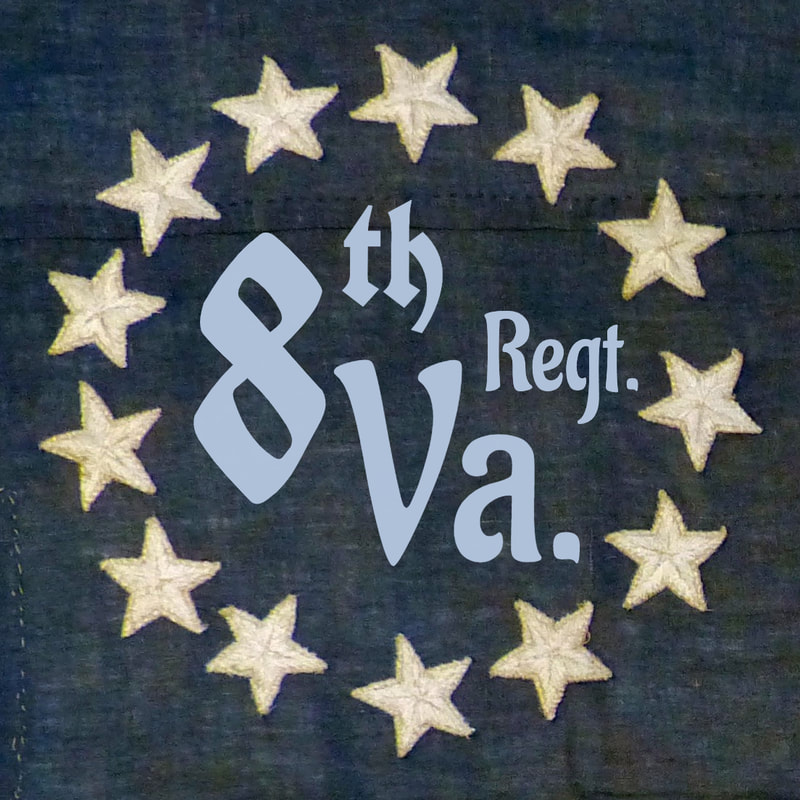|
The soldiers of the 8th Virginia were, typically, Presbyterian or Lutheran--that is to say Irish or German. There were others, including Anglicans, German Reformed, Baptists, and a Jew. There were probably no Catholics, though they would serve under one (the Marquis de Lafayette) and by "Irish" we have to say "Scotch-Irish," "Irish Protestant," or "Ulster Irish" to distinguish these men from later Irish Catholic immigrants. At the time, though, they were usually just called "Irish," despite the Scotch heritage many of them had. When these soldiers or their parents first settled in the parts of today's Virginia, West Virginia and Pennsylvania that then made up the Virginia frontier, their respective churches helped them in their travels and new settlements. The "Great Philadelphia Wagon Road" was the "Oregon Trail" of the colonial era--immigrants arrived in boats at Philadelphia or the nearby Delaware ports of New Castle or Lewes and then, often with church support, headed west along a road that stretched through Lancaster and York into Pennsylvania's Cumberland Valley. That valley continues south to become the Shenandoah Valley in Virginia. The Wagon Road followed it and continued on, eventually all the way to Georgia. After the French and Indian War, the Forbes Road could be followed from the Cumberland Valley as far as Pittsburgh, though that wasn't strictly legal. In the 1770s, other settlers took another branch through the Cumberland Gap in southwest Virginia to Kentucky. (The Cumberland Valley and the Cumberland Gap are far from each other, but both are named for Prince William, the Duke of Cumberland--the youngest son of George II and the victor of the Battle of Culloden in 1746.) The Derry Church in what is now Hershey, Pennsylvania supported Scotch-Irish Presbyterian settlers as they headed west and seeded new churches for them as new communities formed. These new churches were often just log houses, but a number of them survive. It was precisely the same pattern of activity in the Lutheran Church that brought Peter Muhlenberg down the Wagon Road to Woodstock, Virginia in 1772. When he arrived, the Woodstock church was a simple log chapel in the middle of the central intersection. In 1774, land was given to build a new log church at the Southeast corner of the intersection--a project that was overseen by the young rector. It was from that new church that he gave his famous recruiting sermon in 1776. The central role of religion in history is sometimes overlooked or disregarded, especially by elite historians who look too cynically at it. Religious leaders, like Muhlenberg, were not just pastors but also pioneers, political leaders, and soldiers as well. That might seem strange to some people today, but it wasn't strange at all in the 18th and 19th centuries.
5 Comments
Ed Dammer
2/6/2020 07:04:42 am
I was wondering where the 18th (and early 19th) century churches shown in the article "Frontier Churches Paved the Way" are located. Very interesting topic!!
Reply
Mary Kergall
2/6/2022 11:40:50 am
John Peter Gabriel Muhlenberg was an Anglican minister and crossed the Atlantic to England to be ordained. His Diary of that voyage is still in the hands of some of his descendants..
Reply
David Peters
2/6/2022 09:07:05 pm
Gen. Muhlenberg is my 2nd cousin x 7. This area I call "No-Man's Land" the Western and Central Pennsylvania and Maryland and Northwestern Virginia frontier produced some the most ardent patriots and finest soldiers and officers of the War. Daniel Morgan, James Crawford, and his 1/2 brother Hugh Stephenson, Richar Butler and his brothers, Peter Muhlenberg, Arenas McKay, the Minor brothers, the Ogle brothers, Michael Cresap, William Chambers, Van Swearingen, Wm. Smallwood, Daniel Boone, Simon Kenton and many others. This were the first companies of Virginia and Maryland Riflemen and Thompson's Batt. made their "Bee Line" march to Boston in 1775: Home of the 8th and 13th Va., the 8th Pa, and rifle companies of Mile's and Thompson's Regiments.
Reply
David Peters
2/6/2022 09:41:06 pm
On Peter Muhlenberg, I have a good bit of information on him, He was the grandson of the Indian Agent, Frontiersman and F & I Col. Conrad Weiser through his second eldest daughter Anna Maria and Rev. Henry Muhlenberg (founder of the Lutheran Church in America), His uncle Benj Weiser (they were close in age) was a Cpt. in the German Bn. and later Lt. Col. of the 12th Pa. on the Sullivan Expedition, my 6th GF Sgt. Jacob Weiser was also in the 12th, he was a nephew of Benj. and cousin of P.M. Muhlenberg's Weiser cousin served in various Pa. Line Regts., including Peter Weiser a Lt. in the 1st Pa. who died of wounds received at Germantown, Many served in militia battalions of Berks, Lancaster and Northumberland Counties. One a militia Capt. escorted the Liberty Bell to Allentown from Phila. His Pickard cousins served in the NY militia and fought under Gen. Herkimer at Oriskany, although one was a Loyalist in Butler's Rangers
Reply
David Peters
2/6/2022 11:35:03 pm
Derry Church in Hershey is mentioned, Over 30 patriots are buried there. This area of what is now Dauphin County, then Lancaster County. Mostly militia and rangers that served under Col. John Rodgers and Capt. Thom Robinson. Many men from the area served early in the Liberty Co. of Derry Twp., and the Hanover Associators, part the Lancaster Co. Flying Camps.
Reply
Leave a Reply. |
Gabriel Nevilleis researching the history of the Revolutionary War's 8th Virginia Regiment. Its ten companies formed near the frontier, from the Cumberland Gap to Pittsburgh. Categories
All
Archives
June 2024
© 2015-2022 Gabriel Neville
|

 RSS Feed
RSS Feed